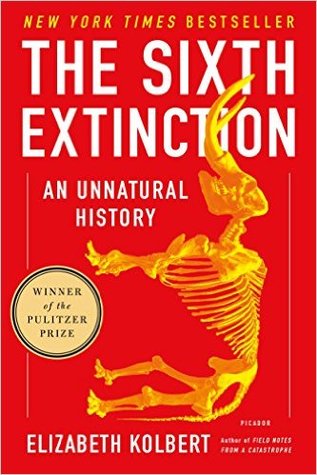More on this book
Community
Kindle Notes & Highlights
AUTHOR’S NOTE
Hi, Elizabeth Kolbert here - the author of The Sixth Extinction and – more recently – Under a White Sky: The Nature of the Future. I want to thank everyone who’s reading The Sixth Extinction (and these notes). My hope in annotating the book is to provide some background to the book and also some updates. I hope they’re helpful!
Davide Fusi and 525 other people liked this
See all 19 comments
· Flag
Welby Cox · Flag
آلاء تمام · Flag
Carumbau
Beginnings, it’s said, are apt to be shadowy.
The prologue of the book was inspired by Rachel Carson and the “fable” that opens “Silent Spring.” I’m a huge Carson fan, and the prologue was an experiment in trying to emulate her voice.
Andrew Breza and 109 other people liked this
Today, amphibians enjoy the dubious distinction of being the world’s most endangered class of animals; it’s been calculated that the group’s extinction rate could be as much as forty-five thousand times higher than the background rate.
Since The Sixth Extinction was published, a new fungal pathogen, known as B. Salamandrivorans, or Bsal, has been discovered. A relative of Bd, it kills salamanders instead of frogs. Fortunately, not long after Bsal was discovered, the U.S. imposed a ban on the importation of hundreds of species of salamanders. It’s hoped by restricting the international trade in salamanders, the spread of Bsal can be stopped, or at least slowed.
Ms.pegasus and 125 other people liked this
That night it poured, and in my coffinlike hammock I had vivid, troubled dreams, the only scene from which I could later recall was of a bright yellow frog smoking a cigarette through a holder.
The frog-hunting expedition I took with Edgardo Griffith was incredible – one of the most memorable experiences of my reporting career. But that night in the claustrophobic, rain-soaked hammock also felt like one of the longest of my life!
Cheryl and 72 other people liked this
It became the world’s first blockbuster exhibit and set off a wave of “mammoth fever.”
While I was writing The Sixth Extinction, I really wanted to see Peale’s mastodon. But I never managed to; as a result of a complicated chain of events, it’s now owned by a museum in Darmstadt, Germany, and I didn’t manage to make it there. As I write this, in January, 2021, the mastodon is on loan to the Smithsonian Museum, in Washington, D.C., for a special exhibit. I am hoping to catch it there, but so far have been stymied by COVID.
Carol Neves and 93 other people liked this
Crutzen wrote up his idea in a short essay, “Geology of Mankind,” that ran in Nature. “It seems appropriate to assign the term ‘Anthropocene’ to the present, in many ways human-dominated, geological epoch,” he observed. Among the many geologic-scale changes people have effected, Crutzen cited the following:
In a recent paper in the journal Nature, researchers calculated that the weight of human-made objects, which includes everything from our houses and cars to asphalt and heavy machinery is now equal to or greater than all the world’s biomass. This is yet another sign that we have entered the Anthropocene.
Ken Mack and 106 other people liked this
Would we finally settle the Fiji question?
After reading The Sixth Extinction, one of the researchers I met at One Tree sent me an email telling me I was lucky I hadn’t been attacked by a shark that night. I am glad I didn’t know about the danger of a shark attack while I was out there wandering around on the reef, chest-deep in water, in the pitch dark.
Josh Goldman and 52 other people liked this
“That’s not like finding another kind of oak or another kind of hickory,” Silman observed. “It’s like finding ‘oak’ or ‘hickory.’”
A few years after I travelled to the Andes with Miles Silman, the new genus received a formal name. It is now known as Incadendron.
Matthias Schlegel and 48 other people liked this
By the official count, there are something like thirteen hundred species of birds in the Amazon, but Cohn-Haft thinks there are actually a good many more, because people have relied too much on features like size and plumage and not paid enough attention to sound.
Not long after I I met up with Mario Cohn-Haft in Manaus, a team of researchers he was part of announced that it had found 15 new species of birds in the Amazon, including the crooked-beaked woodcreeper, which has a beak shaped like a dough hook, and the flat-beaked sucunduri, a small, greenish flycatcher.
Regina Verdeschi and 74 other people liked this
“Suci did not ovulate,” Roth announced to the half-dozen zookeepers who had gathered around to help. By this point, her entire arm had disappeared inside the rhino.
Sadly, not long after I visited the Cincinnati Zoo, Ipuh died. Then, not long after that, Suci, too, died, from a disease known as hemochromatosis, which was probably hereditary. (Her mother, Emi, had also died from this.) At that point, there was just one Sumatran rhino left in the U.S., Suci’s brother, Harapan, who had spent most of his life at the Los Angeles Zoo and Botanical Gardens. Harapan has since been moved to a rhino reserve in Indonesia, where it’s hoped that he will eventually sire a calf. The situation for Sumatran rhinos remains dire.
Wanda and 65 other people liked this
It doesn’t much matter whether people care or don’t care. What matters is that people change the world.
The ending of The Sixth Extinction is the jumping off point for my new book, UNDER A WHITE SKY. I hope you’ll read that, too!
https://www.goodreads.com/book/show/54814834-under-a-white-sky
Valentina Paoli Tinius and 131 other people liked this


